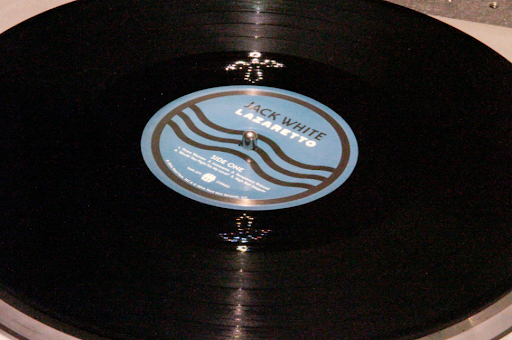Hologram, Liquid Filled, & X-ray Records, Oh My!
Despite the plethora of modern streaming platforms and the revival of vinyl records, you shouldn’t miss these unique record pressings and their eye-catching appearance.
Written by Catalina Perez
Photo courtesy of Blood Records
Despite the popularity of streaming services, vinyl records sales have seen a resurgence, attracting a new generation of listeners. At your local record shop, you’ll find standard black vinyls, colored pressings, picture-discs, and even some limited edition records. What many don’t know, however, is that there is a world beyond just the standard customizations of vinyl records. Whether bought as collector’s items or just to spice up one’s record collection, here are five unique types of record pressings that you may not have known exist.
Filled Records
Photo courtesy of Blood Records
Scorpions, neon liquid, and glow-in-the-dark sand are just a few of the different types of fillings that can be sealed inside of records. Although specific to each artist and pressing company, not much can be found about how specific filled vinyls are made or even the origins of filled vinyl records. However, one specific musician and vinyl artist, Curtis Godino, specializes in making liquid filled records. In interviews, he details creating his own oil wheels to fill airtight sealed vinyls with liquid. He also details a project he did involving a blood-filled Friday the 13th vinyl for Waxwork Records. With record labels and pressing companies such as Romanus Records and Waxwork Records creating filled records, they are becoming more common despite criticism and concerns over liquid filled records leaking. Nonetheless, filled vinyl records are being pressed with music from artists such as Jack White’s liquid-filled “Sixteen Saltines,” King Gizzard and the Lizard Wizard’s scorpion-filled Polygondwanaland, and their glow-in-the-dark sand-filled Teenage Gizzard variant record.
Zoetrope Records
Photo courtesy of Blood Records
Designed after Zoetrope animation discs, a popular early animation technology, zoetrope records are unique to the picture-disc category of vinyl records, appearing as though a looping video is playing while the record spins. Created in the mid-19th century, Zoetrope animation discs worked by setting pictures inside a drum that would rotate and create the illusion of movement or animation. Much like filled-records, not much is known about the origin of zoetrope records; however, there is a mid-20th century child’s toy by “Red Raven Children’s Movie Records”, which features songs such as “The Little Red Engine” and “Old Macdonald Had A Farm” on a zoetrope record. Blood records, a modern-day vinyl record platform, has released different zoetrope vinyls such as Muse’s Will of the People, Royal Blood’s Typhoons, and Foals’ Life is Yours, amongst other records.
X-Ray Records AKA Bone Music
Photo courtesy of Paul Heartfield
During the Cold War, literature and music was subject to state censorship in the Soviet Union, meaning the beginnings of Jazz, Big Band, and rock-and-roll occurring in the West, were heavily restricted. However, recording lathes were brought back to the Soviet Union from Germany as trophies after World War II, inspiring citizens to take matters into their own hands regarding censorship. Thus, an underground bootleg record business commenced, pressing music onto used X-Rays to secretly sell and distribute music which was banned in the Soviet Union at the time, hence the name X-Ray Records, or Bone Music. Fast forward to the modern 21st century, the X-Ray Audio Project, which was created in appreciation of Bone Music, boasts an online archive, documentary, and a book — amongst other media — to shine a light on the unique history of Bone Music. Also, X-Ray records can still be bought on sites like eBay, with songs such as Jimi Hendrix’s “May This Be Love,” Led Zeppelin's “Whole Lotta Love,” and The Rolling Stones’ “Stupid Girl.”
Vinyl Postcards
Photo courtesy of VinylPost
Aloha from Hawaii, Howdy from Dallas, Ciao from Italy. Similar to previously discussed X-Ray records, songs or audio recordings are pressed into the front of a postcard, with some even including the ability to write a note on the back side of the card. Vinyl Post, a company specializing in vinyl postcards, sells cards that you can buy and offers a subscription to a monthly record club, in which you can subscribe to receive a monthly vinyl postcard from emerging indie artists. The subscription includes a song from the artist on the postcard, as well as a special note from the artist on the back. Vinyl Post also does custom vinyl postcards that you can order and add a voice recording or music to.
Hologram Records
Photo courtesy of Tristan Duke
Hologram records may look like regular records at first glance, but they come to life when spun. Not to be confused with colorfully holographic or iridescent records, hologram records show a fascinating image which almost seems to hover over the record whilst spinning. Only a select number of records have been made using hand-etched hologram techniques. Tristan Duke, a holographic artist and photographer for his studio, Infinity Light Science, is the mastermind behind record holograms. In a video explaining a hologram record he made for “Star Wars: The Force Awakens,” Duke explains the process behind holograms, detailing that he creates grooves on the record that record light instead of sound. In addition to “Star Wars: The Force Awakens,” Duke has also created a hologram on Jack White’s Lazaretto, and Rush’s 2112, amongst other vinyl records.
Whether they’ve been filled with real scorpions or printed on an arm X-Ray, these beautiful rarities are some that have been displayed and appreciated by all vinyl-lovers alike. Although the popularity of streaming services and standard colored vinyls overshadow these unique pressings, they are hidden gems amongst the common world of records.






